- You are here:
- Home »
- Training With a Ball
Category Archives for Training With a Ball
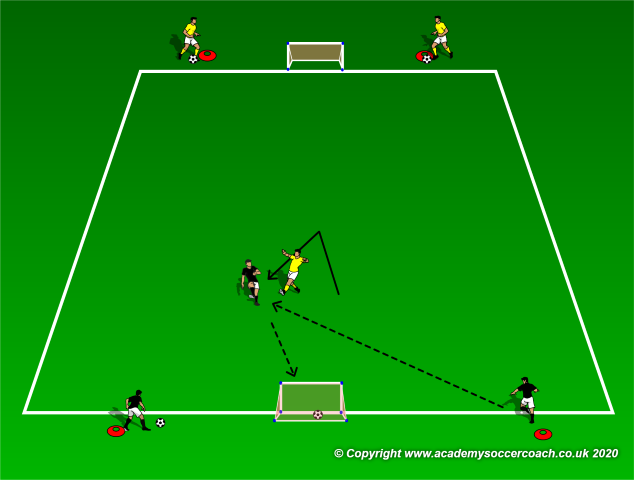
Lose Your Marker to Score Conditioning Game
By Philip Cauchi
Theme: Rapidity.
Development of the soccer domains:
Technical: Receive and control the ball while moving at speed. Finish with accuracy.
Tactical: Getting unmarked to receive the ball.
Mental: Quick thinking under opposition pressure of what moves to perform to lose the defender.
Physical: Perform rapid movements while maintaining the body in a state of equilibrium.
Organisation: An area measuring 12 yards by 12 yards. Outside players called feeders are positioned as shown in the first diagram.
Training load:
Sets: 2.
Repetitions: 4-6.
Duration each repetition: 6 to 8 seconds.
Recovery between repetitions: 60 to 80 seconds (work to rest ratio of 1:10).
Recovery between sets: 3 minutes (light technical activity may be performed during this period thus accelerating the recovery process).
N.B. This practice is beneficial both for attackers who need to create space and for the defenders who must track and mark tightly the attacker close to the goal.
Periodization: The exercise should be carried out immediately after the warm-up when the players are fresh and two days prior to a match (MD-2).
Targeted energy system: Anaerobic alactic (produce energy rapidly with minimal lactic acid build-up).
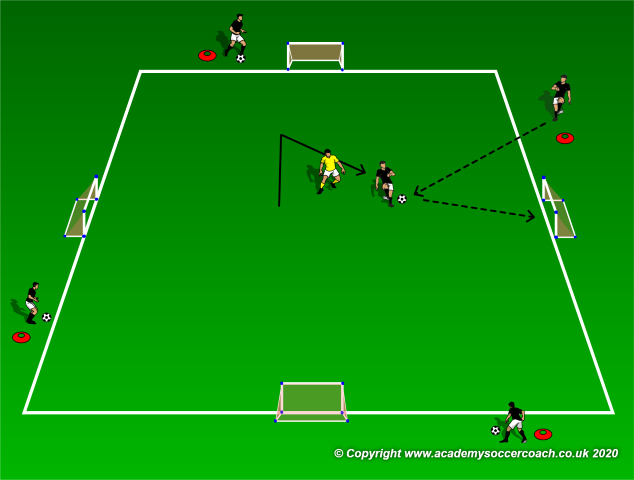
The attacker inside the marked area aims to lose the defender to receive the ball from any of the feeders positioned outside the area. The attacker can move to receive the ball from another feeder after finishing the first action. However, this must be performed within 8 seconds.
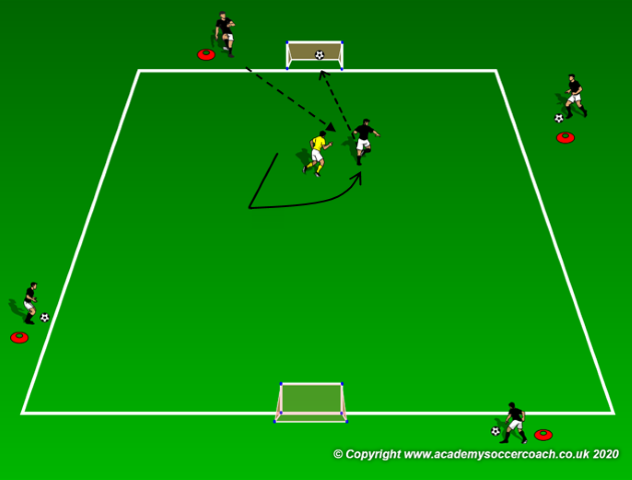
Progression 1 – The attacker can score in only two goals which are positioned opposite each other. This makes it more challenging for the attacker to get unmarked and score.

Progression 2 – Each player inside the area has two feeders on the same goal line. After the attacker concludes his action he must defend. Therefore, roles are changed immediately.
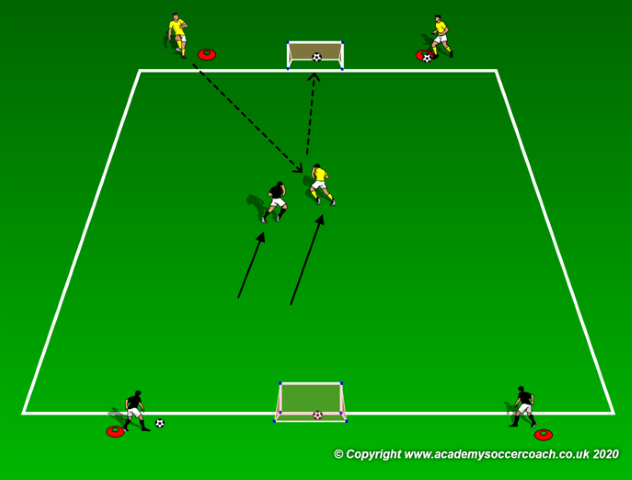
Transition occurs as now the defender becomes the attacker and immediately moves to receive a ball and score in the opposite mini goal.
By Philip Cauchi
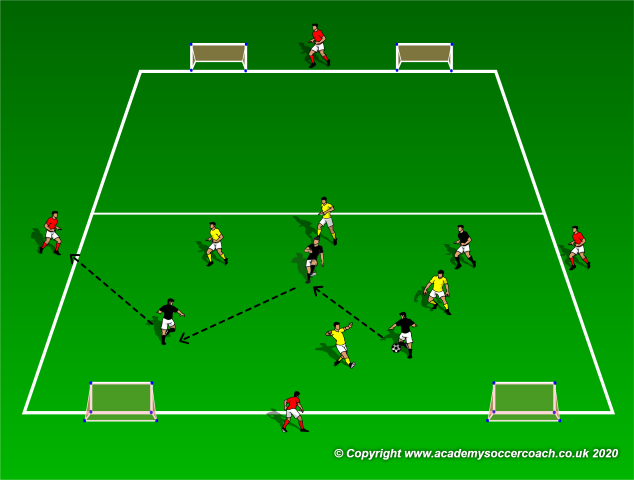
4v4+4 Aerobic High Intensity
By Philip Cauchi
Development of the soccer domains:
Technical: Maintain the quality of technical actions high for a prolonged period of time.
Tactical: In the offensive phase, circulate the ball rapidly with the intention of playing vertically. When the ball is played vertically, the players should quickly provide the target player with support. In the defensive phase, the defending team should recover quickly to prevent the opponents from scoring, win the ball and initiate a counter attack.
Mental: Players should be able to make quick and correct tactical decisions when defending, attacking and during moments of transition for a prolonged period of time.
Physical: Be able to apply the correct technical actions while delaying the onset of fatigue.
Social: Collaborate and communicate with teammates effectively throughout the game. The players should be able to quickly identify and react to their teammates’ movements (visual communication). For example, one player applies pressure on the ball-carrier while the nearby defender covers.
Organisation: Three teams of four players each. Area measuring 40 yards by 30 yards and which is divided into two equal horizontal zones of 20 yards in length each.
Training load:
Series: 6.
Duration each repetition: 3 minutes.
Recovery between repetitions: 1 minute 30 seconds (thus working with a ratio of 1:0.5).
N.B. The training load should be adjusted according to the physical level of the players. With high level players we can have longer durations, more series and also a lower recovery period.
Periodization: The exercise should be carried out after the warm-up as we want the quality of the soccer actions to be high. It should be carried out three days before match day (MD-3).
Targeted energy system: Anaerobic lactic.

The attacking team (blacks) aims to play the ball to the opposite target player (neutral red player).
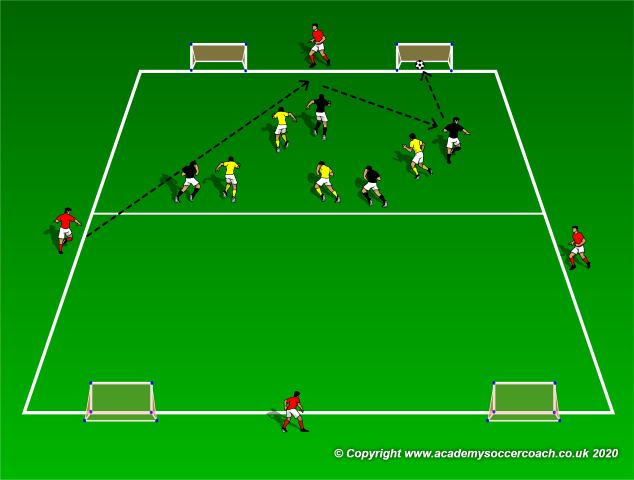
Once the ball is played to the target player, all the players from both set of teams move into the opposite half. The blacks aim to score, while the yellows try prevent the blacks from scoring, win the ball and counter on the opposite two mini goals.
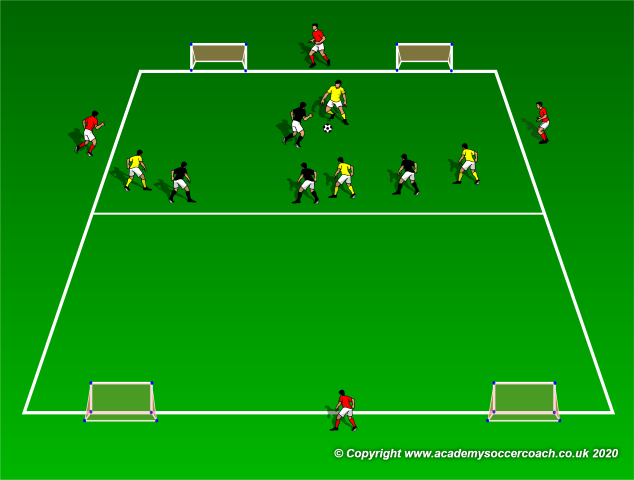
If the yellow team win the ball they aim to counter in the opposite half in the same way.
Variations:
1. The ball must only be played on the ground.
2. The ball may be played high.
3. Play takes place inside one half of the practice area. If the attacking team scores after combining with the target player from their own half, the goal counts twice. Any other means of scoring such as dribbling the ball into the opposite half counts as a single point.
Progression:
1. To further increase the physical and mental intensity, for a goal to count all members of the attacking team must be in the opposition’s half of the practice area at the moment of scoring. Furthermore, all the players of the defending team must be in their team’s defensive zone. Otherwise if a goal is scored the opponents are awarded double the points.
2. Another method of increasing the level of intensity is to play with the same conditions as in progression 1 but have the two halves of the pitch separated by five meters. This zone is known as the ‘no man’s land’. The dimensions of each half should remain the same.
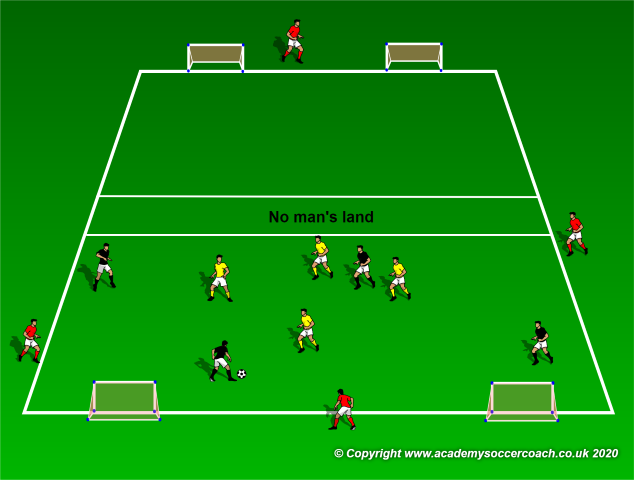
Progression 2. Increasing the running distance of the players with the introduction of the ‘no man’s land’.
N.B. After each series change the neutral flank and target players.
By Philip Cauchi
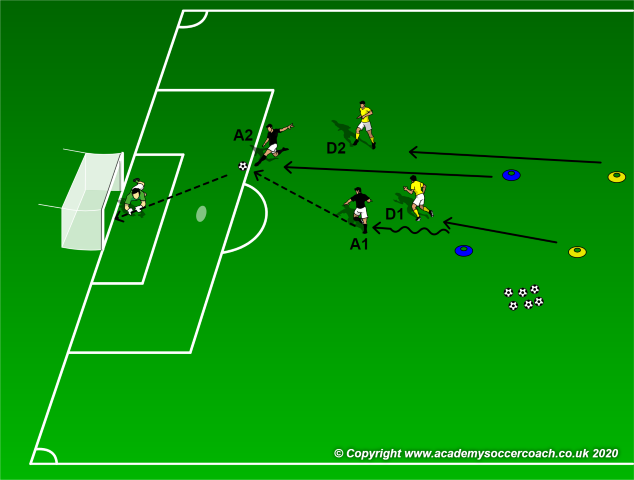
2v2+GK Explosive Sprints
By Philip Cauchi
Development of the soccer domains:
Technical: Quality of technical actions performed at speed and under opposition pressure. Turn with the ball, dribble at speed, pass with accuracy, oriented first touch and finish at goal with accuracy.
Tactical: In the offensive phase, provide quick support in attack while timing forward runs. Follow up shots for rebounds while attacking both the first and second post areas. In the defensive phase, recover quickly to prevent the attackers from concluding at goal.
Mental: In the offensive phase, keep focused while performing attacking actions under pressure from opponents. In the defensive phase, the players must track back and defend with a positive attitude of preventing the opponents from scoring.
Physical: Applied soccer actions performed at speed to either attack or defend.
Social: Collaborate and communicate (verbal and non-verbal) with teammate to either score or defend.
Training load:
Sets: 2.
Repetitions: 6.
Duration each repetition: 3 to 4 seconds.
Recovery between repetitions: 30 to 40 seconds (thus working at a ratio of 1:10).
Recovery between sets: 3 minutes (light technical activity may be performed during this period thus accelerating the recovery process).
N.B. The training load should be adjusted according to the physical level and maturity of the players. Players should be positioned within positions and situations they typically experience during a match.
Periodization: The exercise should be carried out immediately after the warm-up when the players are fresh and two days before match day (MD-2).
Targeted energy system: Anaerobic alactic.
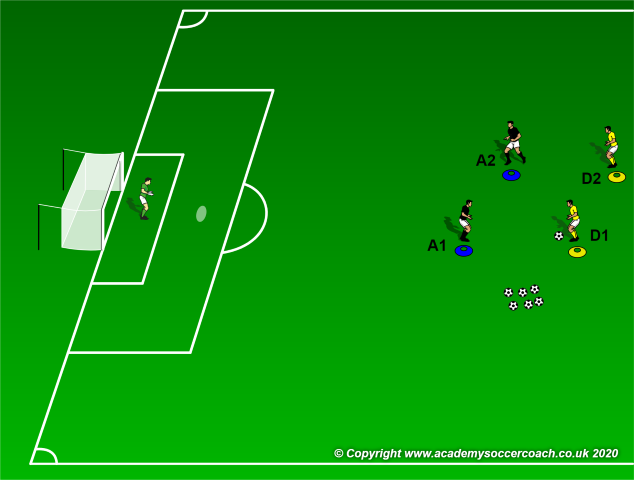
Attacker A1 starts facing the defender D1 two yards apart. Defender D1 starts with a ball at his feet. Defender D2 starts slightly behind and three yards away from defender D1. Attacker A2 is positioned 2 yards in front of defender D2.
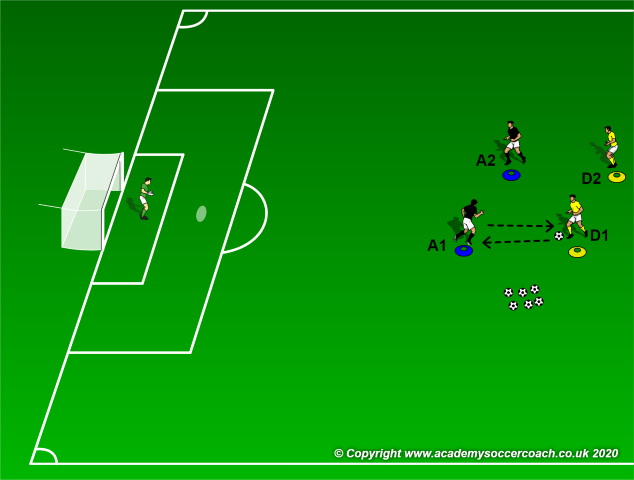
Attacker A1 and defender D1 pass the ball back and forth to each other.

Attacker A1 turns at his discretion to dribble towards the goal. At this moment all the other players become active. Attacker A1 must pass the ball to attacker A2 to finish on goal. The attackers have a time limit to score from the moment attacker A1 turns to attack the goal. The offside rule is in effect.
Progression 1:
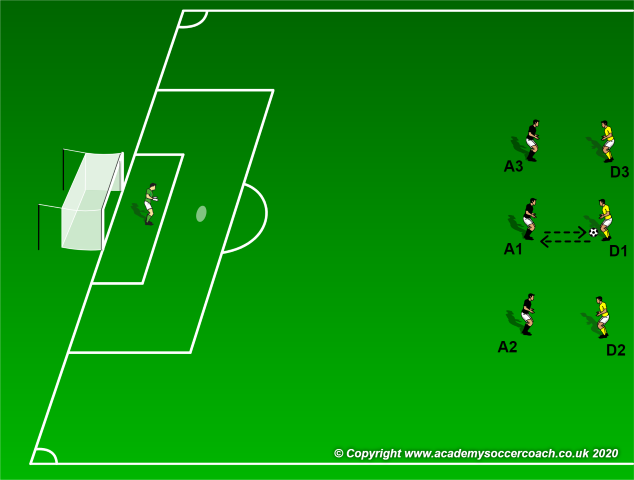
Now we play 3v3 with the offside rule is in effect.
Progression 2:
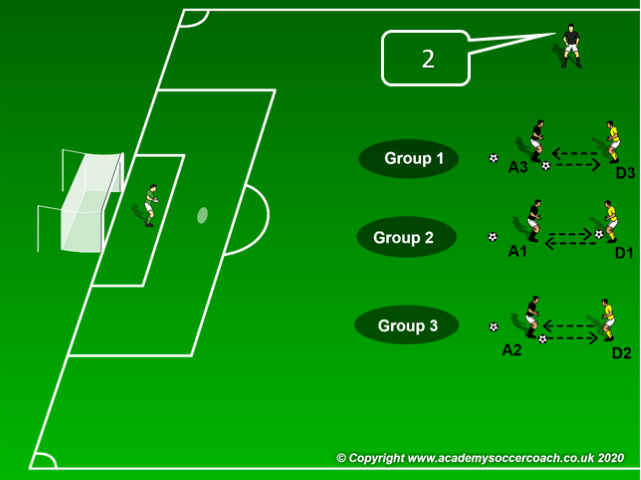
The attackers and defenders in all three groups pass the ball back and forth to each other. The coach calls out a number that represents a specific group. The attacker in this group must quickly turn and dribble the ball positioned one yard behind him. The other two attackers and the three defenders must quickly react to this visual stimulus. The attackers must score after all of them have touched the ball. If this proves to be too hard or slows down the action, remove the constraint that all the attackers should touch the ball before attempting a shot on goal. Instead we can challenge the attackers by having them finish at goal in five seconds or less from the moment the coach calls the player to initiate the attack.
By Philip Cauchi
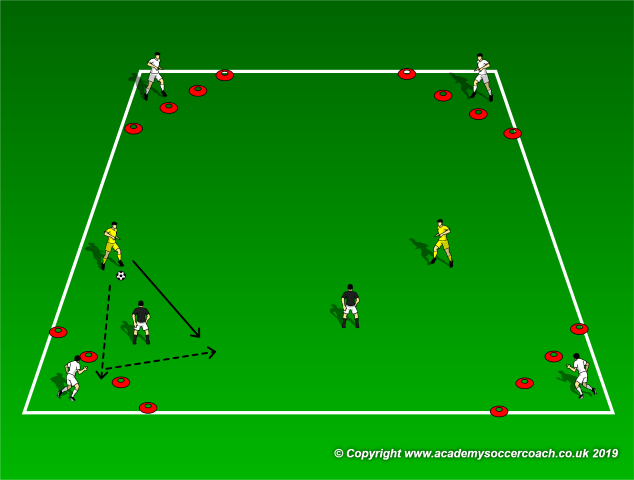
Corner Combination Play
By Anthony Hazelwood
The following activity has an 18 x 18 yd. box area where players will play 2 vs. 2. An additional triangle on each side is placed three yards from each side. Pairs will play for 90 seconds and then switch/rotate with corner players. This will achieve adaptations in the anaerobic energy system and produce soccer specific muscle tension actions.
When preparing the activity, if needed, concentration and difficulty levels may be increased by having players execute something extra unique by setting more restrictions. Every activity may be modified, and it is up to the coach to be creative. However, it is important to respect the parameters of the exercise time, the rest, the types of actions used and the weekly periodization of the activity.
Additionally, it is beneficial to train a soccer team and its players with all the elements of the game is present in the session. By doing so, it will promote soccer specific adaptations to the player’s body, mind, and emotional triad. Ultimately, these adjustments will enhance their real-time game performances on a physical, emotional, conscious, and subconscious mental level.
Area Size: 18 d. x 18 yd.
Total Activity Time: 12 minutes.
Sets: 1.
Number of Repetitions: 8
Activity Repetition Time: 90 seconds
Recovery Interval Time between reps: Quick transition between inside and corner players.
Intensity: High.
Objectives:
• Tactical: Improve combinations plays.
• Fitness: Maintain high intense corporal actions.
• Technique: Proper fitness and off/on the ball execution/techniques.
• Mental-Emotional: Players fully engaged and concentration is high.
• Concentration Level: High.
Setup:
• Create an 18 x 18-yard grid with triangle at each corner.
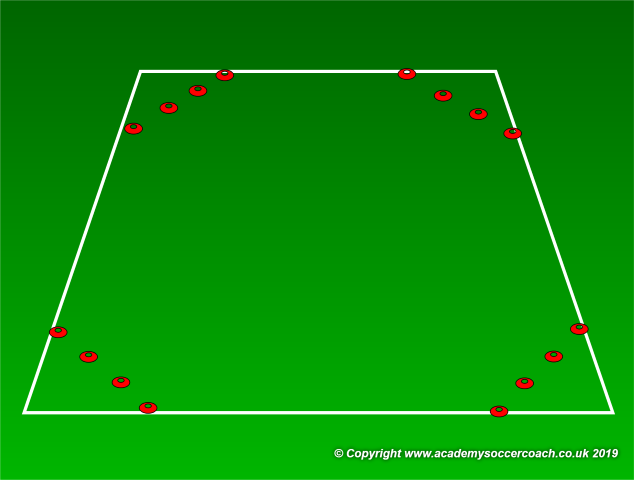
• Put players into players (Two pairs in the inside) and place one corner player in each zone.
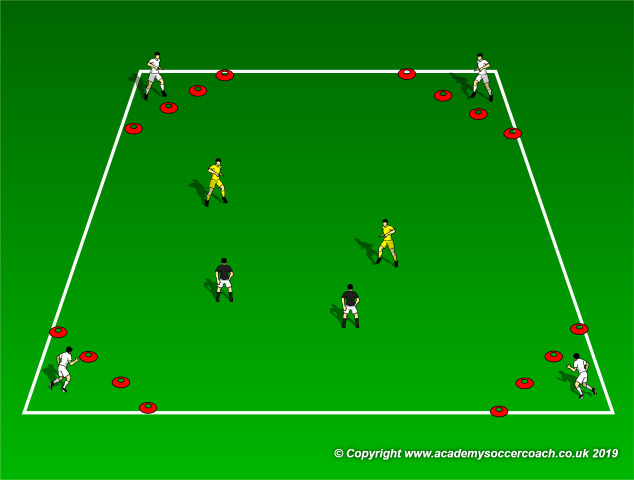
• Pairs play for 90 seconds and try to combine with each other or with a corner player for points.

• Third man combination.
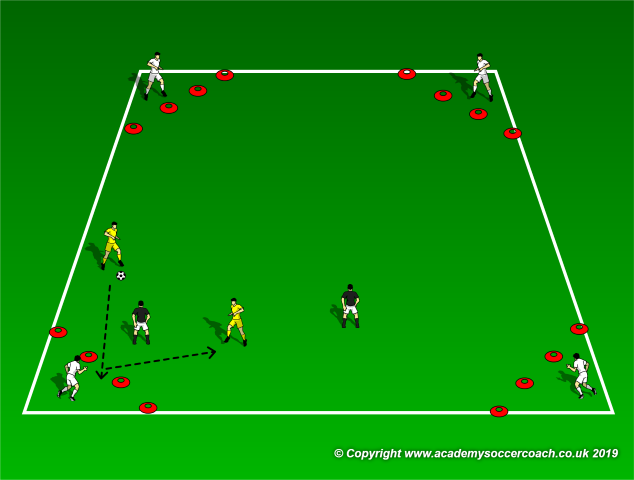
• After 90 seconds players quickly rotate and commence the next 90 seconds.
Activity Point System:
• 1 point for corner play wall pass.
• 2 points for Third man combination or inside pair wall pass.
• One touch everywhere.
• Progression: when a point is scored corner players rotate to the next corner quickly.
Coaching Points:
• Support.
• Verbal and nonverbal communication.
• Dribble to opponent use teammate for combo play.
By Anthony Hazelwood
Coach Anthony is a USSF “A” licensed coach with an M.S. in Sports Training and Nutrition and a B.S. in Physical Education. Currently, he is an Assistant and Sports Performance coach with the Miami FC. He has previous European youth academy coaching experience as a soccer fitness and strength/conditioning assistant coach with Levante U.D. and Getafe SAD in Valencia and Madrid, Spain.
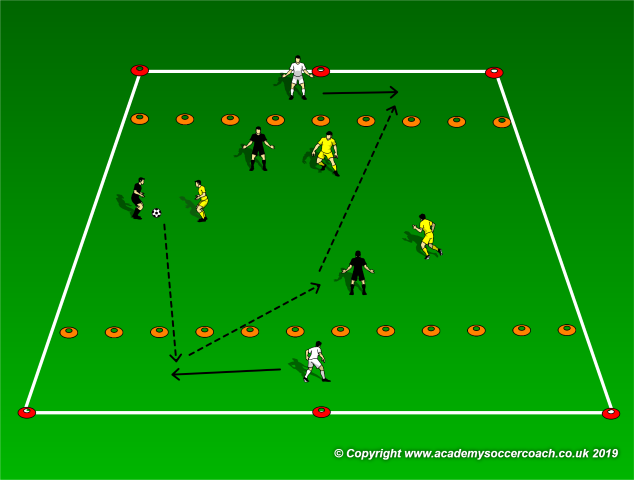
3v3 Change the Point of Attack for Anaerobic Capacity
By Anthony Hazelwood
The following activity has two teams of three playing a 3 vs. 3 possession game including two bumper neutral players. Team play 3 vs. 3 in a middle zone and keep possession with a bumper player located at each side of the grid. The idea is for the team in possession to keep the ball by using the width to break out of pressure. The specific fitness target is intermittent endurance while adapting the player’s anaerobic capacity in a small sided group format.
When preparing the practice, if needed, concentration and difficulty levels may be increased by having players execute something extra unique by setting more restrictions. Every activity may be modified, and it is up to the coach to be creative. However, it is important to respect the parameters of the exercise time, the rest, the types of actions used and the weekly periodization of the activity.
Additionally, it is beneficial to train a soccer team and its players with all the elements of the game being present in the session. By doing so, it will promote soccer specific adaptations to the player’s body, mind, and emotional triad. Ultimately, these adjustments will enhance their real-time game performances on a physical, emotional, conscious, and subconscious mental level.
Area Size: 20 yds. L x 30 yds. W and an extra 5 yd. zone on each side.
Total Activity Time: 18 minutes.
Sets: 1 set.
Activity Repetitions: 6 repetitions.
Time of Activity Repetition: 2 minutes.
Recovery Time: 1 minute.
Intensity: High.
Objectives:
• Tactical: Switching the point of attack, possession, support.
• Fitness: Muscle Tension activity with anaerobic capacity training adaptations.
• Technique: Proper fitness and off/on the ball execution/techniques.
• Mental-Emotional: Players fully engaged and concentration is high.
• Concentration Level: High.
Setup:
• Mark out a 20 yds. L x 30 yds. W and an extra 5 yd. zone on each side.

• Two teams of three in the middle zone and add a bumper player on each side of the grid.

• Play begins with a team trying to combine and make 7 seven points to score a goal.

• Two points are awarded if the ball circulates from side to middle player to side player.
• Progression: Make 5 passes and then cross over line (make it directional).
Coaching Points:
• High competitive mindset.
• Verbal and Non-Verbal Communication off and on the ball.
• Support
• Ball Circulation
• Body angles
By Anthony Hazelwood
Coach Anthony is a USSF “A” licensed coach with an M.S. in Sports Training and Nutrition and a B.S. in Physical Education. Currently, he is an Assistant and Sports Performance coach with the Miami FC. He has previous European youth academy coaching experience as a soccer fitness and strength/conditioning assistant coach with Levante U.D. and Getafe SAD in Valencia and Madrid, Spain.

Team Defensive Transition – Aerobic Capacity – Match Endurance
By Anthony Hazelwood
The following activity educates a team to defensively transition effectively and stop the opponent from breaking into their attacking third. The specific fitness target is match endurance while adapting the player’s aerobic capacity in an extended small-sided format.
When preparing the activity, if needed, concentration and difficulty levels may be increased by having players execute something extra unique by setting more restrictions. Every activity may be modified, and it is up to the coach to be creative. However, it is important to respect the parameters of the exercise time, the rest, the types of actions used and the weekly periodization of the activity.
Additionally, it is beneficial to train a soccer team and its players with all the elements of the game being present in the session. By doing so, it will promote soccer specific adaptations to the player’s body, mind and emotional triad. Ultimately, these adjustments will enhance their real-time game performances on a physical, emotional, conscious, and subconscious mental level.
Area Size: Full Pitch with a 65 yds. Length X Full Width Area.
Total Activity Time: 20 Minutes.
Sets: 1.
Intervals: 2.
Activity Time: 9 minutes.
Recovery Interval Time between Sets: 2 minutes.
Intensity: High.
Objectives:
• Tactical: Transitional Defensive practice – avoid opponents pass into defensive third.
• Fitness: Aerobic Capacity – Match Endurance.
• Technique: Proper fitness and off/on the ball execution/techniques.
• Mental-Emotional: Players fully engaged and concentration is high.
• Concentration Level: High.
Setup:
• Full Pitch with 65 yd. L x Full Width initial playing area.
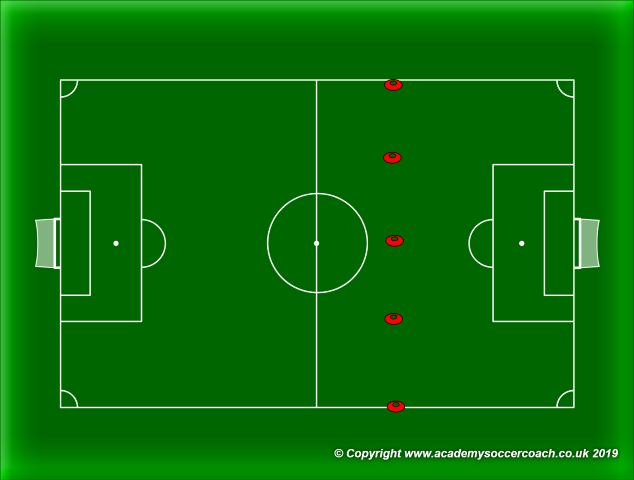
• Black team (1-4-3-3) looks to score in 65 x full width pitch.
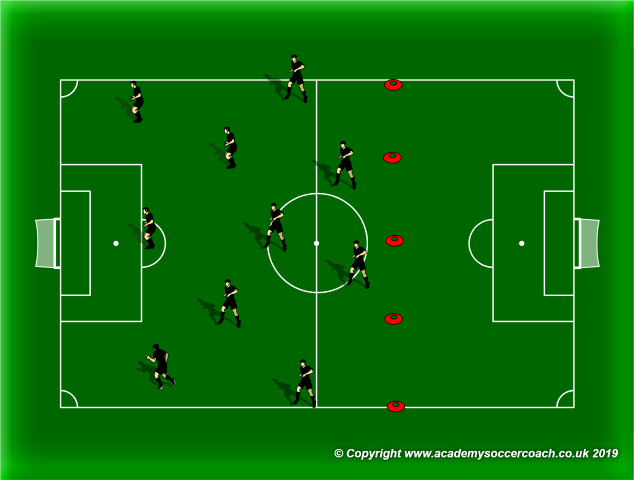
• Yellow team (1-4-4-2) looks to regain possession to go to goal and score.
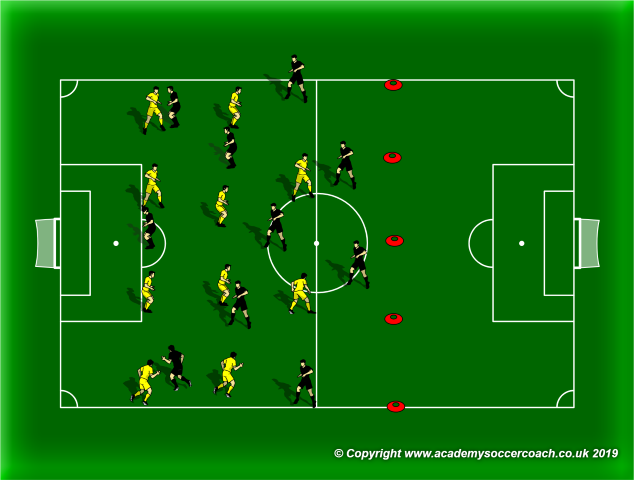
• Ball always starts with Black team in the initial playing zone. Throw-ins and corners are always in play in playing area.
• The Black team work to score goals and if they score, they keep ball that is given at the line of cones.
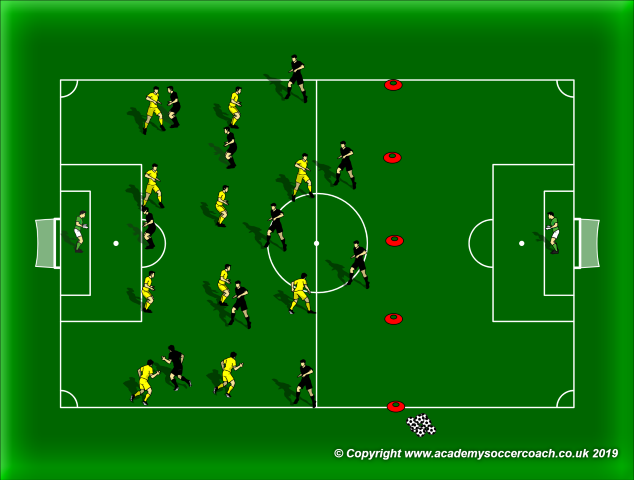
• If the yellow team regains possession of the ball during free play, the black team must perform a high intense pressure to retrieve the ball.

• If the yellow team passes the red line and break into their attacking third and score or the ball goes out of bounds, the play restarts and black team receive ball at red line.
• The objective is for Black team to defensively transition effectively and stop the opponent from breaking into their attacking third.
Coaching Points:
• Defending tactics is up to the coach, but the work rate to perform this activity when transitioning to defense on a physical level needs to be shows.
• This activity will develop a team’s match endurance potential specifically targeting high pressure defensive attributes on transitional defensive moments.
By Anthony Hazelwood
Coach Anthony is a USSF “A” licensed coach with an M.S. in Sports Training and Nutrition and a B.S. in Physical Education. Currently, he is an Assistant and Sports Performance coach with the Miami FC. He has previous European youth academy coaching experience as a soccer fitness and strength/conditioning assistant coach with Levante U.D. and Getafe SAD in Valencia and Madrid, Spain.
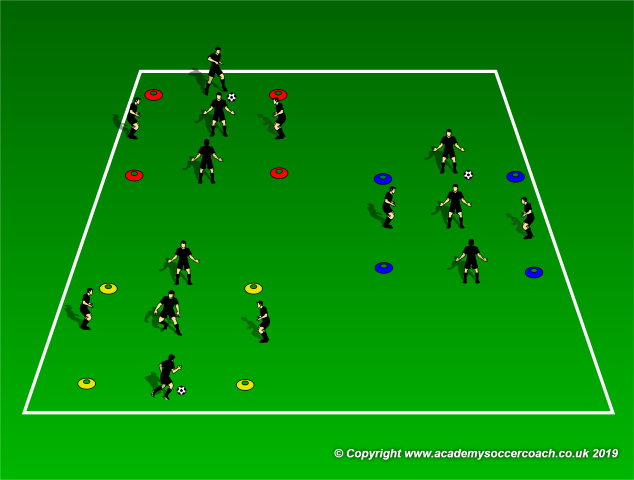
Sprinting Rondos
By Anthony Hazelwood
The following activity has three 10 yd. x 10 yd. rondo areas at 15 yards away from each other. Each rondo grid will have 5 players and they will play a 4 vs. 1 activity. When playing, the defender in the middle just needs to touch the ball to rotate with another player. At the coach’s signal, the players will print clockwise to the next rondo grid located 15 yards away. The last player to reach the grid will start in the middle. These types of activities are great for athletic speed development. Rest times should be extensive as to completely recover for the next signal. It’s important that each sprint is done maximally — proper rest between sprints is important. 30 seconds rondo play before each sprint should be performed as this activity helps adapt the creatine phosphate system.
When preparing the activity, if needed, concentration and difficulty levels may be increased by having players execute something extra unique by setting more restrictions. Every activity may be modified, and it is up to the coach to be creative. However, it is important to respect the parameters of the exercise time, the rest, the types of actions used and the weekly periodization of the activity.
Additionally, it is beneficial to train a soccer team and its players with all the elements of the game is present in the session. By doing so, it will promote soccer specific adaptations to the player’s body, mind, and emotional triad. Ultimately, these adjustments will enhance their real-time game performances on a physical, emotional, conscious, and subconscious mental level.
Area Size: Three 10 yd. x 10 yd. rondos
Total Activity Time: 10 minutes.
Sets: 2.
Number of Repetitions: 10
Recovery Interval Time between reps: 30 seconds.
Intensity: High.
Objectives:
• Tactical: Attacking Diamond shape in rondo – Proper supporting positions.
• Fitness: Maintain high intense corporal actions.
• Technique: Proper fitness and off/on the ball execution/techniques.
• Mental-Emotional: Players fully engaged and concentration is high.
• Concentration Level: High.
Setup:
• Create Three 10 yd. x 10 yd. rondo grids.
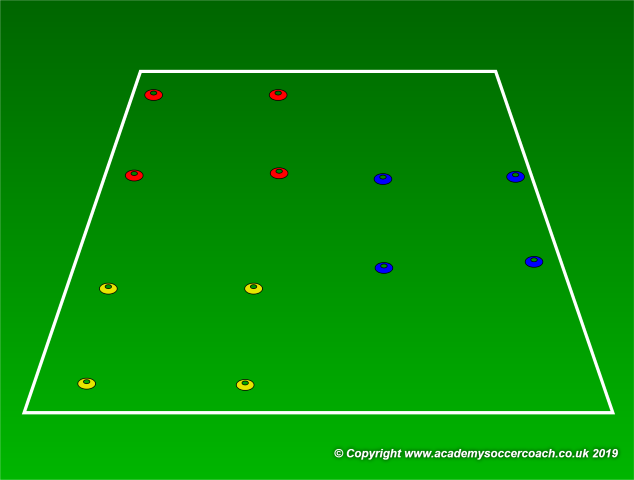
• Place five players in each grid and make it a 4 vs. 1 scenario.

• Begin playing a 4 vs. 1 for 30 seconds.
• On the coach’s whistle, players sprint clockwise to the next rondo grid.
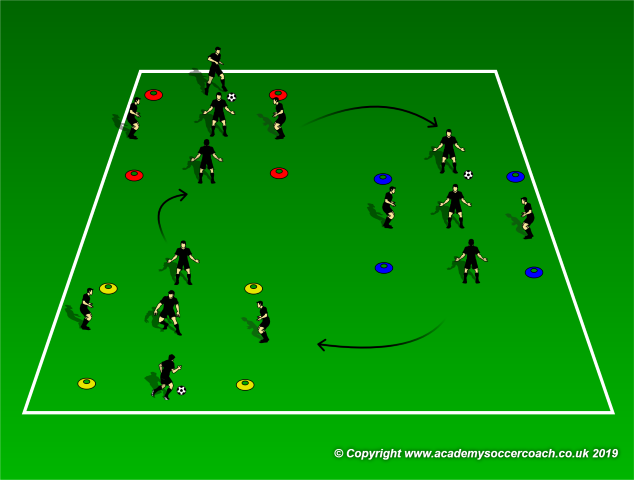
• To add, if the coach whistles twice, the players will sprint counter clockwise.
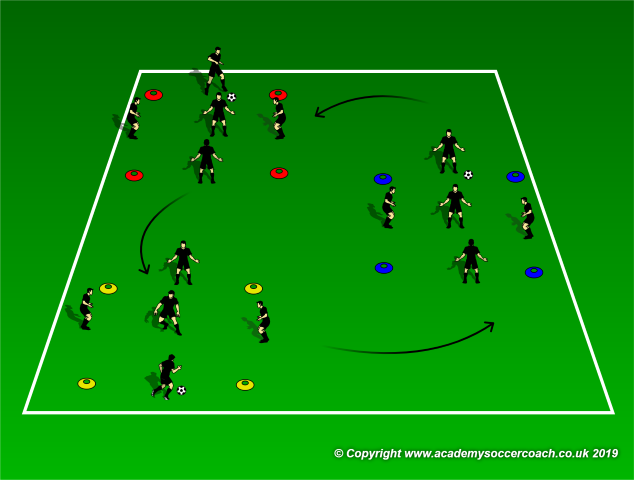
Activity Progression:
• One touch play.
• One – Two touch play.
Coaching Points:
• High intensity.
• Proper technique and Proper Exercise Movement.
By Anthony Hazelwood
Coach Anthony is a USSF “A” licensed coach with an M.S. in Sports Training and Nutrition and a B.S. in Physical Education. Currently, he is an Assistant and Sports Performance coach with the Miami FC. He has previous European youth academy coaching experience as a soccer fitness and strength/conditioning assistant coach with Levante U.D. and Getafe SAD in Valencia and Madrid, Spain.

1v1 Speed Reaction
By Anthony Hazelwood
The following activity has a 15 yd. x 15 yd. playing area where two teams split up and form a single file line located at the sides of the grid. On the coach’s signal, the first player from each line will sprint to the cone located at the middle of the grid. Once there, the coach will call out a color. Once the color is called, players must react and sprint through the corresponding colored gates. First player to reach and pass the gates wins. These types of activities are great for athletic speed development. Rest times should be extensive as to completely recover for the next round. It’s important that each sprint is done maximally — proper rest between sprints is important.
When preparing the activity, if needed, concentration and difficulty levels may be increased by having players execute something extra unique by setting more restrictions. Every activity may be modified, and it is up to the coach to be creative. However, it is important to respect the parameters of the exercise time, the rest, the types of actions used and the weekly periodization of the activity.
Additionally, it is beneficial to train a soccer team and its players with all the elements of the game is present in the session. By doing so, it will promote soccer specific adaptations to the player’s body, mind, and emotional triad. Ultimately, these adjustments will enhance their real-time game performances on a physical, emotional, conscious, and subconscious mental level.
Area Size: 15 yd. x 15 yd.
Total Activity Time: 10 minutes.
Sets: 1.
Number of Repetitions: 10
Recovery Interval Time between reps: 1:8.
Intensity: High.
Objectives:
• Tactical: Decision Making to cone gates.
• Fitness: Maintain high intense corporal actions.
• Technique: Proper fitness and off/on the ball execution/techniques.
• Mental-Emotional: Players fully engaged and concentration is high.
• Concentration Level: High.
Setup:
• Create a 15 x 15-yard grid with pairs of cones on each sided.
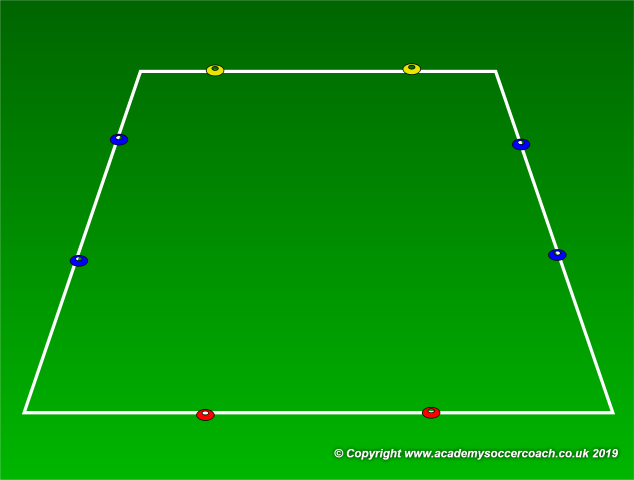
• Place a cone in the middle of grid — Create two teams of eight team and place them in a single file line at sides (blue cones).
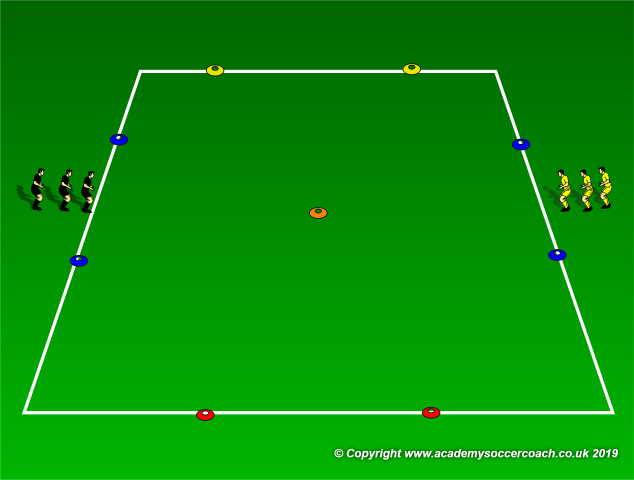
• On coach’s whistle, first player from each line will sprint to the middle cone.
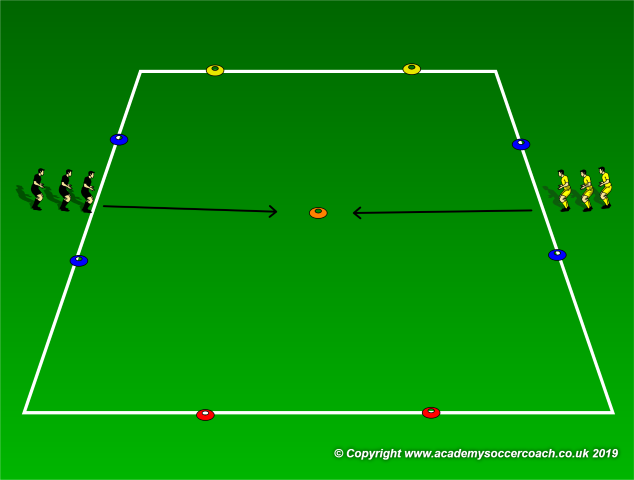
• Once there, players will be on toes and coach will yell out a color.
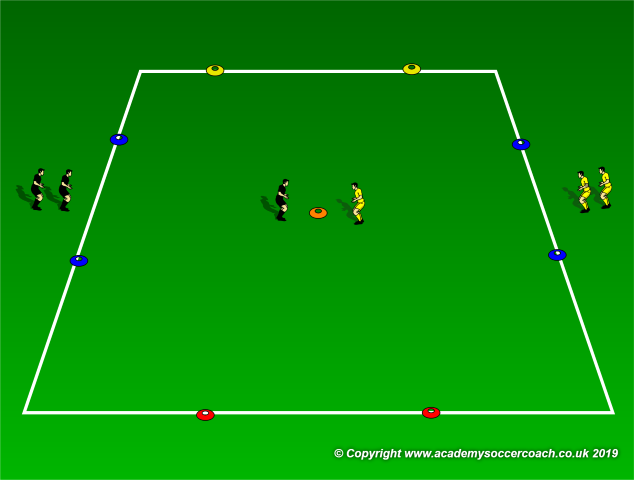
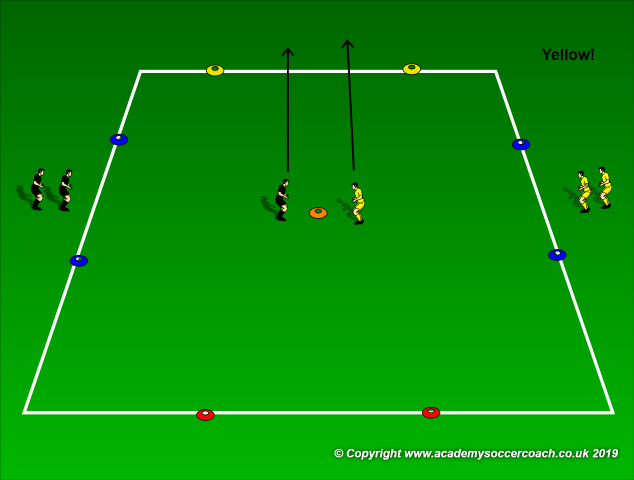
• Once completed, players return to their lines and wait their turns.
Activity Progression:
• Play with a soccer ball.
• Blue coned gates are in play.
Coaching Points:
• High intensity.
• Proper technique and Proper Exercise Movement.
By Anthony Hazelwood
Coach Anthony is a USSF “A” licensed coach with an M.S. in Sports Training and Nutrition and a B.S. in Physical Education. Currently, he is an Assistant and Sports Performance coach with the Miami FC. He has previous European youth academy coaching experience as a soccer fitness and strength/conditioning assistant coach with Levante U.D. and Getafe SAD in Valencia and Madrid, Spain.
